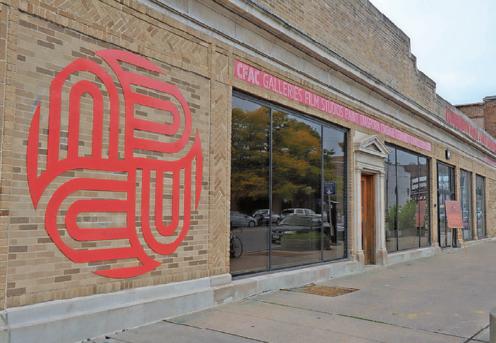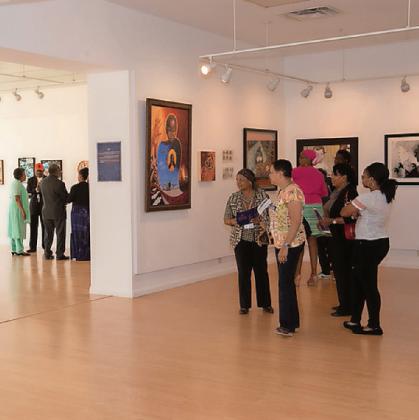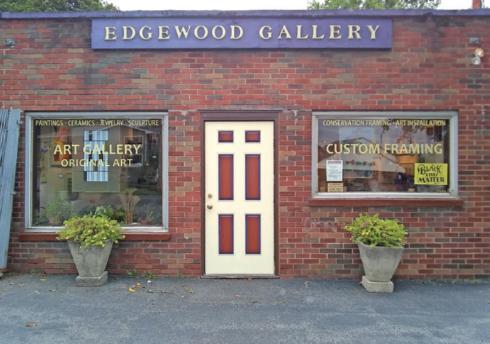
7 minute read
Art Profile
GOING WITH THE FLOW

Advertisement
BY KATHERINE RUSHWORTH
The impact of COVID-19 on the museum world has been devastating. Forced to close their doors to visitors in the middle of March, many did not reopen until mid-July or early August. Months passed when admission fees could not be collected, fundraising events had to be cancelled or postponed and instructional classes were either forced to go online or were cancelled altogether.
The situation facing the museums and galleries in Syracuse was, and is, no different.
We recently sat down with directors of three diverse Syracuse city museums and galleries to discuss the impact the closings had on their organizations and how the on-going pandemic is altering their business models. We spoke with Elizabeth Dunbar, director and CEO of the Everson Museum of Art, Tanisha Jackson, executive director of the Community Folk Art Center and Cheryl Chappell, owner of the Edgewood Gallery. As a group they represent the diversity of our arts community, but they share a common experience.
PHOTO COURTESY EVERSON MUSEUM OF ART ElizabEth Dunbar Director and CEO of the Everson Museum of Art

Dunbar says the Everson saw a 30 percent loss in income during the shutdown. Admission fees stopped. Onondaga County funding was cut in half. The Annual Summer Picnic, the organization’s largest fundraiser, was canceled. The Summer Art Camps were also canceled. Outside organizations that scheduled events in the museum pulled out of their commitments. These were all revenue generators for the museum.
Going forward, Dunbar says exhibition dates will be extended and instead of working with national artists, curators will be relying more on the Everson’s permanent collection to develop shows and cut expenses. There were also plans to open the much-anticipated museum café this fall, but that date has been pushed out to the summer of 2021.
“There’s no rush to finish it [the café], if people can’t use it,” Dunbar says.
When the Everson shut down on March 15, the staff had to act quickly. Dunbar says the education and curatorial staffs pivoted on a dime. Garth Johnson, the curator of ceramics, set up a weekly online seminar during which he provided a detailed discussion about one of the ceramic objects in the museum’s collection. It was free and it was a hit.
“We made connections far beyond the Syracuse community with this,” Dunbar says of the webinars. “We had curators from the Met, the Brooklyn Museum and Ulysses Dietz from the Newark Museum watching.”
She expects these webinars to continue, but with less frequency.
The education staff developed Creativity Kits for sale that provided a fully outfitted, self-contained art activity for kids. It helped fill the void created when the Summer Art Camps were canceled. The kits sold well and will continue to be available.
Dunbar says she is most proud of being able to keep all the museum’s full-time employees throughout the shutdown. She credits that to the Paycheck Protection Program (PPP).
So, life goes on at the Everson Museum of Art with vestiges of the past married to aspects of a new normal.
Is this a sustainable model?
“No. It’s not sustainable,” Dunbar says. “Some parts are sustainable and it’s great to have the online components, but we have to get people back in the building.”
Tanisha Jackson
Executive Director, Community Folk Art Center
The Community Folk Art Center (CFAC) was forced to close its doors on March 16 and did not reopen until July 17. That reopening was restricted to only Syracuse University faculty, staff and students as a way to mitigate the exposure to COVID-19 between SU and metro-Syracuse communities. Tanisha Jackson, CFAC’s executive director, says being a unit of Syracuse University’s Department of African American Studies is part of the organization’s function, but they are also an independent 501(c)(3), which allows them to reach beyond the university’s walls into the broader community.
“That was the biggest impact on us as an organization,” Jackson says about the closure and restricted reopening. “We are a bridge between the community and SU, but that bridge right now is a little one-sided. We don’t have any community foot traffic.”
CFAC weathered the COVID-19 storm fairly well since they had the extensive resources of SU to back them up.
“Our overhead and general operating budget is through SU,” Jackson says. “That’s what keeps us operating and sustainable. Without SU we wouldn’t be sustainable.”
While no staff were let go during the shutdown, two key positions that Jackson was about to fill had to be put on hold due to the financial pressures the university was also experiencing. CFAC’s budget also took a five percent cut.
But that didn’t mean there still wasn’t work to be done. Jackson took the downtime as an opportunity to revamp CFAC’s online presence. So, in addition to the organization’s home page (communityfolkartcenter.org), which lists events and programs, there is now a new virtual gallery (cfacgallery.com) that invites visitors to take an online tour of past and present exhibitions.
“We now have exhibitions in perpetuity,” Jackson says.
She also began developing and hosting a podcast, titled “Black Art Speaks” and like the Everson, CFAC initiated plans to shift art instruction online.
“Online art instruction, the virtual gallery, the podcast series are ways in which we will respond to COVID- 19,” Jackson says.
So, while the nature of CFAC’s day-to-day functions have changed due to COVID-19, the organization does not have to live with degree of uncertainty felt at other arts organizations. It helps to have the backing and resources of Syracuse University.
“This has been a time for us to be innovative,” Jackson says. “Yes, COVID-19 is a terrible thing, but it has allowed us to not just sustain our organization, it has made us think about how we can do things differently.”


PHOTOS COURTESY COMMUNITY FOLK ART CENTER
Cheryl Chappell
Owner, Edgewood Gallery
When the Edgewood Gallery closed its doors on March 19, owner Cheryl Chappell got a new job description.
“My job became battling the unemployment system and trying to get a PPP (Paycheck Protection Program) loan,” Chappell says. “That became my job. That’s what I was doing for eight hours a day for the first few weeks we were shut down.”
The New York State unemployment system was not prepared for the deluge of applications following the state-wide shutdown. Persistence and patience were key to breaking through the unintentional, but very real barriers. Chappell worked through KeyBank for the PPP loan, which was designed to keep employees on the payroll even though they aren’t necessarily working full time for the organization. The loan would be fully forgiven if the funds were used to cover payroll costs, interest on mortgages, rent and utilities. Chappell used the PPP funds to cover her payroll (she is the sole employee) and rent. So, she’s in good shape.
“Everything worked out for me and I am so grateful,” she says. “Without PPP I would have been hurt.”
The gallery reopened on June 2 and Chappell says she was immediately busy. People had spent 10-12 weeks in their homes venturing out only for necessities or an occasional walk.
PHOTOS COURTESY EDGEWOOD GALLERY
“When I reopened, I had a very good three weeks of people coming in,” she says. “I was really busy in June and July. People were so excited to be out and they were buying like crazy.”
While Chappell’s gallery is small in scale, she must still operate within the state-mandated COVID-19 protocols. She allows a maximum of only four people in the gallery at a time. There’s a Plexiglas cover, which she can sanitize, over the counter where she works with customers to choose frame and mat options. She repeatedly wipes down doorknobs with sanitized wipes and she keeps the air conditioner running while the front door to the gallery remains open for better ventilation. She says virtually everybody who has come into the gallery has worn a mask. No problem.
She credits the COVID-19 shutdown with people realizing the importance of a comfortable home that reflects who they are. That’s why she was so busy after she reopened.
“Art is the soul of the house,” Chappell says. “People were shut in and needed to add to their homes. It was the treat they were giving to themselves.”









